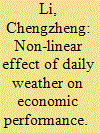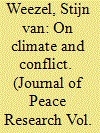| Srl | Item |
| 1 |
ID:
182776


|
|
|
|
|
| Summary/Abstract |
This paper thoroughly examines the impacts of daily weather on the aggregate economic outcomes in China and identifies the underlying channels. Using within-county variations in daily weather between 1996 and 2012, we find that daily temperature and precipitation have non-linear effects on county-level economic outcomes. An additional day with an average temperature above 20 °C reduces county-level GDP by 0.05% to 0.08%, and the detrimental effects tend to intensify when the temperature rises. The precipitation does not have robust effects on county-level GDP. By examining the effects of daily weather on primary, secondary, and tertiary industries, we find that the primary industry is the main channel of the negative impacts of high temperatures. Heavy precipitation is inclined to harm agricultural output, especially grains and oil crop yields. Besides, we discover heterogeneous responses to weather extremes across counties and find suggestive evidence of adaptation.
|
|
|
|
|
|
|
|
|
|
|
|
|
|
|
|
| 2 |
ID:
167279


|
|
|
|
|
| Summary/Abstract |
This study exploits a sudden and abrupt decline in precipitation of the long rains season in the Horn of Africa to analyze the possible link between climate change and violent armed conflict. Following the 1998 El Niño there has been an overall reduction in precipitation levels – associated with sea-surface temperature changes in the Indian and Pacific Oceans – resulting in an increase in the number and severity of droughts. Given that the probable cause of this shift is anthropogenic forcing, it provides a unique opportunity to study the effect of climate change on society compared to statistical inference based on weather variation. Focusing on communal conflict in Ethiopia and Kenya between 1999 and 2014, exploiting cross-sectional variation across districts, the regression analysis links the precipitation decline to an additional 1.3 conflict events per district. The main estimates show that there is a negative correlation between precipitation and communal conflict with a probability of 0.90. Changing model specification to consider plausible alternative models and accommodate other identifying assumptions produces broadly similar results. The generaliziability of the link between precipitation decline and conflict breaks down when using out-of-sample cross-validation to test the external validity. A leave-one-out cross-validation exercise shows that accounting for climate contributes relatively little to improving the predictive performance of the model. This suggests that there are other more salient factors underlying communal violence in Ethiopia and Kenya. As such, in this case the link between climate and conflict should not be overstated.
|
|
|
|
|
|
|
|
|
|
|
|
|
|
|
|